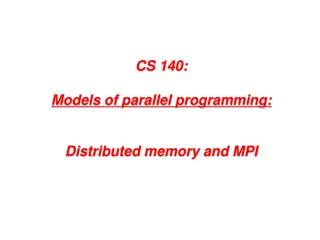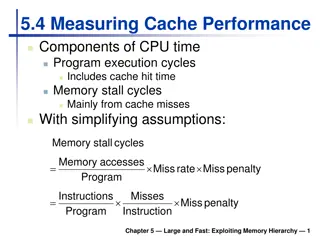Understanding Memory Hierarchy and Different Computer Architecture Styles
Delve into the concepts of memory hierarchy, cache optimizations, RISC architecture, and other architecture styles in embedded computer architecture. Learn about Accumulator and Stack architectures, their characteristics, advantages, and example code implementations. Explore the differences between RISC, Register-Memory, and Memory-Memory architectures through code examples. Gain insights into the design choices and trade-offs involved in selecting different architecture styles for efficient computing.
Download Presentation

Please find below an Image/Link to download the presentation.
The content on the website is provided AS IS for your information and personal use only. It may not be sold, licensed, or shared on other websites without obtaining consent from the author. Download presentation by click this link. If you encounter any issues during the download, it is possible that the publisher has removed the file from their server.
E N D
Presentation Transcript
Embedded Computer Architecture 5SAI0 Memory Hierarchy Part I Henk Corporaal www.ics.ele.tue.nl/~heco/courses/ECA h.corporaal@tue.nl TUEindhoven 2021-2022
Topics Memory Hierarchy Part I Memory hierarchy motivation Caches direct mapped set-associative Basic cache optimizations Part II (Dec 1) Advanced cache optimizations Memory design Virtual memory Address mapping and Page tables, TLB => Material book: Ch2 + App B (H&P) / Ch 4 (Dubois) But first: Other Architecture Styles 2
Remember RISC? Keep it simple RISC characteristics: Reduced number of instructions Limited number of instruction sizes (preferably one) know directly where the following instruction starts Limited number of instruction formats Limited addressing modes load-store architecture enables pipelining Large register set uniform (no distinction between e.g. address and data registers) Memory alignment restrictions Pipelined implementation 3
Other architecture styles Accumulator architecture one operand (in register or memory), accumulator almost always implicitly used Stack zero operand: all operands implicit (on TOS) Register (load store) = RISC three operands, all in registers loads and stores are the only instructions accessing memory (i.e. with a memory (indirect) addressing mode Register-Memory two operands, one in memory Memory-Memory three operands, may be all in memory (there are more varieties / combinations) 4
ECA H Corporaal Accumulator Architecture Accumulator latch ALU Memory registersaddress latch Example code: a = b+c; load b; // accumulator is implicit operand add c; store a; 5 10/4/2024
ECA H Corporaal Stack Architecture latch latch top of stack ALU Memory stack pt latch Example code: a = b+c; push b; push c; add; pop a; add pop a push b push c b c b+c stack: b 6 10/4/2024
Other architecture styles RISC Let's look at the code for C = A + B Stack Architecture Push A Accumulator Architecture Load A Register- Memory Memory- Memory Register (load-store) Load r1,A Load r1,A Add C,B,A Push B Add B Add r1,B Load r2,B Add Store C Store C,r1 Add r3,r1,r2 Pop C Store C,r3 Note: in code A stands for (r) where register r contains &a; similar for B,C Q: What are the advantages / disadvantages of load-store (RISC) architecture? 7 H.Corporaal 5MD00
Many addressing modes; RISC uses only 3-4 MODE REGISTER EXAMPLE ADD R4, R3 MEANING reg[R4] <- reg[R4] +reg[R3] ADD R4, #3 reg[R4] <- reg[R4] + 3 IMMEDIATE ADD R4, 100(R1) reg[R4] <- reg[R4] + Mem[100 + reg[R1]] DISPLACEMENT ADD R4, (R1) reg[R4] <- reg[R4] + Mem[reg[R1]] REGISTER INDIRECT ADD R3, (R1+R2) reg[R3] <- reg[R3] + Mem[reg[R1] + reg[R2]] INDEXED ADD R1, (1001) ADD R1, @R3 reg[R1] <- reg[R1] + Mem[1001] reg[R1] <- reg[R1] + Mem[Mem[Reg[3]]] DIRECT OR ABSOLUTE MEMORY INDIRECT ADD R1, (R2)+ ADD R1, (R2) then R2 <- R2+d POST INCREMENT ADD R1, -(R2) R2 <- R2-d then ADD R1, (R2) PREDECREMENT BEZ R1, 100 if R1==0, PC <- PC+100 PC-RELATIVE JUMP 200 Concatenate bits of PC and offset PC-RELATIVE 8 10/4/2024 ECA H Corporaal
Topics Memory Hierarchy Part I Memory hierarchy motivation Caches direct mapped set-associative Basic cache optimizations Classification of cache misses: the 3 C s => Material book: Ch2 + App B (H&P) / Ch 4 (Dubois) 9
Memory Performance Gap single processor performance vs memory latency Huge performance gap between CPU and Memory 10
Memory Hierarchy 11
Memory Hierarchy Design Very crucial with recent multi-core processors: Aggregate peak bandwidth grows with # cores ! Example: Intel Core i7 can generate two references per core per clock With 4 cores and 3.2 GHz clock => 25.6 billion 64-bit data references/second + 12.8 billion 128-bit instruction references = 409.6 GB/s! DRAM bandwidth is only 6% of this (25 GB/s) We need: Multi-port, pipelined caches Two levels of cache per core Shared (between cores) third-level (L3) cache on chip Microprocessors have >> MB on-chip cache; huge area Memory and caches consume much energy 12
Why does a (small) cache work? Your program and data sizes >> cache size ?? LOCALITY !!!!! Temporal: you are likely accessing the same address soon again Spatial: you are likely accessing another address close to the current one in the near future 13
Topics Memory Hierarchy Part I Memory hierarchy motivation Caches direct mapped set-associative Basic cache optimizations Classification of cache misses: the 3 C s => Material book: Ch2 + App B (H&P) / Ch 4 (Dubois) 14
Direct Mapped Cache Mapping: block address modulo the number of blocks in the cache 16
Direct Mapped Cache Address (bit positions) 2 1 31 30 13 12 11 0 Byte offset Q:What kind of locality are we taking advantage of? 10 20 Hit Data Tag Index Index 0 1 2 Valid Tag Data 1021 1022 1023 20 32 17
Direct Mapped Cache Taking advantage of spatial locality: Address (bit positions) 18
Memory hierarchy basics When a word is not found in the cache, a miss occurs: Fetch word from lower level in hierarchy, requiring a higher latency reference Lower level may be another cache or the main memory Also fetch the other words contained within the block Takes advantage of spatial locality Often costs extra cycles delay Place block into cache in any location within its set, determined by address block address MOD number of sets in cache 19
Cache basics Way 3 Set 1 4-ways set-associative cache (Nsets =4): each set contains 4 blocks 20
Cache basics cache_size = Nsets* Assoc * Block_size block_address = Byte_address DIV Block_size (in bytes) index = Block_address MOD Nsets Because the block size and Nsetsare (usually) powers of two, DIV and MOD can be performed efficiently; how? block address block offset 2 1 0 tag index 31 21
Cache performance: metrics & terminology Average memory access time (AMAT) AMAT= hit_time + miss_rate * miss_penalty Miss rate: fraction of accesses not satisfied by the cache (at a certain level Li) Number of misses is divided by the number of processor references Also hit_rate = 1 miss_rate Miss_penalty: average delay per miss caused in the processor If processor blocks on misses, then this is simply the number of clock cycles to bring a block from memory, also called miss latency In a OoO (Out-of-Order) processor, the penalty of a miss cannot be measured directly Different from miss latency Miss rate and penalty can be defined for all cache levels Li 22
Cache performance: metrics&terminology Misses per instructions (MPI) Number of misses in Level_i (Li) divided by number of instructions Easier to use than miss rate: CPI = CPI0+ MPI*miss_penalty Note: speculative and multithreaded processors may execute other instructions during a miss Reduces performance impact of misses 23
4 questions for designers Q1: Where can a block be placed in the upper level? (Block placement) Fully Associative, Set Associative, Direct Mapped Q2: How is a block found if it is in the upper level? (Block identification) Tag/Block Q3: Which block should be replaced on a miss? (Block replacement) Random, FIFO (First-in First-out), LRU (Least Recently Used) Q4: What happens on a write? (Write strategy) Write Back or Write Through (with Write Buffer) 24
Write policies Write through: write to next level on all writes Combined with write buffer to avoid CPU stalls Simple, no inconsistency among levels Write-back: write to next level only on replacement With the help of a dirty bit and a write-back buffer Writes happen on a miss only Allocation on write miss Always allocate in write-back; design choice in write-through 25
Topics Memory Hierarchy Part I Memory hierarchy motivation Caches direct mapped set-associative Basic cache optimizations Classification of cache misses: the 3 C s => Material book: Ch2 + App B (H&P) / Ch 4 (Dubois) 26
Basic Cache optimizations 1. Larger cache capacity to reduce miss rate Increases hit time, increases power consumption 2. Larger block size Reduces compulsory misses (by exploiting more spatial locality) Increases capacity and conflict misses, increases miss penalty 3. Higher associativity Reduces conflict misses Increases hit time, increases power consumption 4. More cache levels Reduces overall memory access time 5. Split L1 data and L1 instruction cache can access data and instructions in parallel, even for single ported caches 27
Cache mapping Direct-mapped: each memory block can be mapped to only one cache line: cache index = block address modulo the number of lines in cache Set-associative: each memory block can be mapped to a set of lines in cache; set number = block address modulo the number of cache sets Fully associative: each memory block can be in any cache line effectively there is only one set 29
Direct Mapped Cache: Problem !?! Many memory addresses map to the same cache line => Conflicts Solution: Associative caches 30
A 4-Way Set-Associative Cache Way 3 Set 1 4-ways: Each set contains 4 blocks Fully associative cache has only 1 set, containing all blocks 31
Replacement policies Random, LRU, FIFO, pseudo-LRU Example: least-recently used (LRU) replacement priority per cache line (11 = should be replaced) 32
LRU Visualised Most Recently Used (MRU) Line 1 - 00 Line 0 - 01 Line 3 - 10 Least Recently Used (LRU) Line 2 - 11 Priority level == index in this stack 33
LRU Visualised Most Recently Used Line 1 - 00 Line 0 - 01 Hit on line 3 Line 3 - 10 Least Recently Used Line 2 - 11 Hit on Line 3 34
LRU Visualised Line 1 - 00 Line 0 - 01 Hit on line 3 Most Recently Used Line 3 - 10 Least Recently Used Line 2 - 11 Line 3 needs to become MRU 35
Hit on line 3 Most Recently Used Line 3 - 10 Line 1 - 00 Line 0 - 01 Least Recently Used Line 2 - 11 Move line 3 to top Indexes need fixing! 36
Hit on line 3 Most Recently Used Line 3 - 00 Line 1 - 00 Line 0 - 01 Least Recently Used Line 2 - 11 line 3 gets index 00 37
Hit on line 3 Most Recently Used Line 3 - 00 Line 1 - 00 +1 Line 0 - 01 Least Recently Used Line 2 - 11 Every line with index lower than old index of line 3 is incremented 38
Hit on line 3 Most Recently Used Line 3 - 00 Line 1 - 01 +1 Line 0 - 10 Least Recently Used Line 2 - 11 Every line with index lower than old index of line 3 is incremented 39
LRU Visualised Most Recently Used Line 3 - 00 Line 1 - 01 Line 0 - 10 Least Recently Used Line 2 - 11 All indexes are up to date 40
LRU Index Update Hardware Most Recently Used Line 3 - 00 Line 1 - 01 Line 0 - 10 Least Recently Used Line 2 - 11 index = hit ? 00 : ( index<hit_index) ? index+1 : index 41
LRU Index Update Hardware Most Recently Used Line 3 - 00 Line 1 - 01 Line 0 - 10 Least Recently Used Line 2 - 11 index = hit ? 00 : ( index<hit_index) ? index+1 : index Mux Sub+Comp Mux Mux Incr. 42
LRU Index Update Hardware Most Recently Used Line 3 - 00 Line 1 - 01 Line 0 - 10 Least Recently Used Line 2 - 11 index = hit ? 00 : ( index<hit_index) ? index+1 : index Mux Sub+Comp Mux Mux Incr. For each way!! 43
Multilevel Caches Primary, level-1 cache attached to CPU Small, but fast Level-2 cache services misses from primary cache Larger, slower, but still faster than main memory Some high-end systems include L-3 cache In that case, main memory services L-3 cache misses Main Memory L3 $ L2 $ CPU L1 $ 44
The cache/memory performance equation Texec= Ncycles Tcycle= Ninst CPI Tcycle with CPI = CPIideal+ CPIstall CPIstall= %reads missrateread misspenaltyread+ %writes missratewrite misspenaltywrite or: Texec= (Nnormal-cycles + Nstall-cycles) Tcycle with Nstall-cycles= Nreads missrateread misspenaltyread+ Nwrites missratewrite misspenaltywrite (+ Write-buffer stalls )
Multilevel Cache: calculate CPI? Let s first look at a 1-level cache: CPU with CPIbase= 1, clock rate = 4GHz Miss rate/instruction = 2% Main memory access time = 100ns What is the CPI with only a L1 cache? CPU Main Memory L1 $ Miss penalty = 100ns/0.25ns = 400 cycles CPI = CPIbase+ miss_rate * miss_penalty = 1 + 0.02 400 = 9 cycles/instruction 46
Example (cont.) Main Memory L2 $ CPU L1 $ Now add L2 cache Access time = 5ns Global miss rate to main memory = 0.5% L1 miss with L2 hit Penalty = 5ns/0.25ns = 20 cycles L1 miss with L2 miss Extra penalty = 400 cycles What is speedup of adding L2 cache? CPI = 1 + 0.02 20 + 0.005 400 = 3.4 cycles/instruction Speedup L2 = 9/3.4 = 2.6 47
Multilevel Cache Considerations L1 cache Focus on minimal hit time Usually separate L1 Instruction and L1 Data cache Why? L2 cache Focus on low miss rate to avoid main memory access Hit time has less overall impact Shared I & D; why? L3 cache Shared between all cores: why? Main Memory L3 $ L2 $ CPU L1 $ 48
Splitting first level cache Use split Instruction and Data caches Caches can be tuned differently Avoids dual ported cache I$ I&D $ Main Memory CPU D$ L1 L2 49
Multi-level cache hierarchies; policies Usually, cache inclusion is maintained When a block misses in L1 then it must be brought into all Li. When a block is replaced in Li, then it must be removed from all Lj, j<i The opposite: exclusion If a block is in Li then it is not in any other cache level Miss in L1 then all copies are removed from all Li s, i>1 If a block is evicted from Li then this block is allocated in Li+1 50
Classification of cache misses: 3 Cs Compulsory (cold) misses: on the 1st reference to a block Capacity misses: space is not sufficient to host data or code Conflict misses: happen when two memory blocks map on the same cache block in direct-mapped or set-associative caches Later we add Coherence misses 4 Cs classification How to measure these misses? Cold misses: simulate infinite cache size Capacity misses: simulate fully associative cache then deduct cold misses Conflict misses: simulate cache then deduct cold and capacity misses 51
3Cs Absolute Miss Rate (on SPEC92) Miss rate per type Conflict 52























